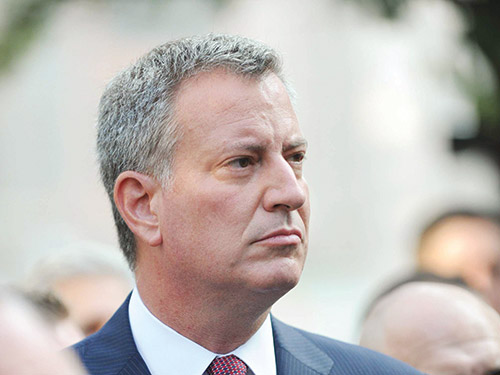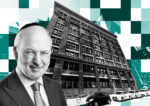Trending
De Blasio: Year One
After 12 months, a clearer picture emerges of mayor’s relationship with real estate issues

It’s no wonder that when the dust settled on the Democratic mayoral primary some 15 months ago, the real estate industry eyed candidate Bill de Blasio with some measure of trepidation.
After all, under mayors Rudy Giuliani and Michael Bloomberg, the industry flourished. For two decades, it could count on at least one sure thing: consistent support from a pro-real estate City Hall. And if there’s one thing any business values, it is consistency.
So when de Blasio called for a “reset” on the relationship between local government and the industry during his campaign, real estate figures naturally wondered what the new order would look like. A year into the new administration, industry figures may not know exactly what they’re getting from de Blasio, but they are starting to get a clearer picture.
“I really think he’s working hard, trying hard,” Donald Trump told several hundred like-minded individuals who gathered at the Jacob K. Javits Center last month for the International Council of Shopping Centers’ trade show. “Obviously he has a very different philosophy than most people in this room.”
Trump, never shy about sharing his opinion, offered conciliatory praise for the mayor, tempered with caution. The boisterous developer said de Blasio and his team, “have been very good, as far as I’m concerned” with regard to advancing Trump Golf Links at Ferry Point, the $236 million golf course in the Bronx that has been stalled for more than a dozen years.
On the other hand, Trump said he was concerned with talk of “tax the rich.” He said he couldn’t believe anyone would let that happen.
“Mike did a great job; Rudy did a great job. I really think that time will tell,” what kind of job de Blasio will do, he said. “I like to give people the benefit of the doubt.”
Tax jitters
Trump’s concern about higher taxes is not unique. In November, a Quinnipiac University poll found that 54 percent of city voters surveyed believed de Blasio would raise taxes.
This perception is likely due to the mayor’s unsuccessful push in the early days of his administration, for a tax hike to pay for universal pre-kindergarten, as well as his public mulling on a proposal for a tax on second homes worth $5 million and up.
De Blasio arrived at City Hall with what he considered a progressive mandate, which caused concern that he might shake things up too much.
“I had a level of concern about what his administration would look like,” Time Equities CEO Francis Greenburger said. “Would it be people who were capable and competent — obviously they’d represent his philosophy — or would they be ideological and less practical?”
By and large, Greenburger said, he’s had positive feelings about the de Blasio appointees he’s met. He added that considering where national discourse is on topics such as middle-class wages and the criminal justice system, people come around to realize the mayor is on to something with his progressive ideas.
“He’s the right person for the right time. It’s about finding the right balance for those issues,” he said. “That’s essential for having a stable environment, and if you don’t have a stable environment, real estate doesn’t do well.”
Of course, another major element of de Blasio’s agenda is affordable housing: the mayor pledged to build 80,000 units and preserve another 120,000 over 10 years. The plan has widespread support from the real estate industry, though there are many questions about how it will be implemented.
“I see clients look at development sites and there’s some uncertainty as to how much you can build if you provide affordable housing onsite or offsite. The industry needs that predictability,” attorney Jay Neveloff of Kramer Levin said, who added that he’s “hopeful that it’s coming.”

Jolie Milstein
Others pointed to moves such as de Blasio’s naming Carl Weisbrod as chairman of the City Planning Commission and reshaping the department of Housing Preservation and Development as signs of real commitment to streamlining the city’s land-use policies.
“We’ve seen a huge shift in priorities compared to the last administration,” said Jolie Milstein, president and CEO of the New York State Association for Affordable Housing, an industry group representing both non- and for-profit developers of affordable housing.
“This mayor’s approach is much more sensitive to the dynamics within neighborhoods,” she added, saying the mayor’s housing plan and the improvements at HPD have encouraged many of those who were on the sidelines to get involved.
Neveloff said he will be looking to the mayor to see how he weighs in on the renewal of the state’s 421a tax abatement program in June, and his stance on affordable housing deals that are nearing their expirations.
It all comes down, he said, to doing a deal both sides can be happy with.
“I was originally concerned, but I’m feeling better and better,” he said. “I’m feeling more confident that there’s a balancing of different interests, and I think that’s important.”
A historic move
The administration ruffled more than a few feathers in early December when news broke that the Landmarks Preservation Commission might remove more than 100 sites from consideration for landmarking.
“I was very disappointed, even though [the proposal] has been tabled,” said Stuart Siegel, the former Sotheby’s CEO who last spring jumped to the European high-end brokerage Engel & Völkers to open its first NYC office. “I don’t think [de Blasio] has embraced the value of historic districting and how it can be supportive of affordable housing.”
Indeed, unused air rights over a historic district are central to discussion surrounding one of the biggest land-use debates right now: developer Howard Hughes’ plan to build a tower near the South Street Seaport.
Another proposal Siegel said he is watching closely is the plan to rezone a few blocks near Grand Central Terminal, where SL Green wants to build its One Vanderbilt tower. He said he hopes it amounts to more than a “pebble in a pond” and that City Hall considers broader Midtown East rezoning.
“I think he got a challenge with the industry and it will be interesting to see how he stewards it,” Siegel said. “In this industry, in a bull market everybody’s a hero, and I think what he’s basically trying to do is create an environment where a lot of people benefit from that market.




